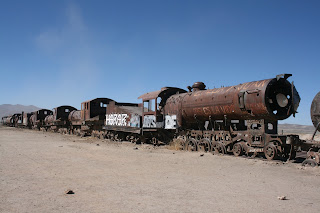We booked ourselves a 3 day tour to go from San Pedro de Atacama in Chile to Uyuni in Bolivia.
We were picked up from our guesthouse early in the morning by minibus and got dropped off first at immigration in San Pedro and then 10km away at the Bolivian border to get our passport stamped. The Bolivian border was in the middle of nowhere surrounded by lovely mountains and snow. It was quite chilly but the driver prepared a breakfast for us with cakes, bread, ham, cheese and nice, warm coffee. From there our other jeep driver was waiting for us and our 3 amazing days started from there.
We were with another German couple the same age as us, Christian and Cristina. We crossed some amazing landscapes, first of all passing by 2 different Lagos, Verde, rojo y Blanco (green, red and white)
Then we crossed the desert of Dali. It is named like this as the landscape looks like some of Salvador Dali’s surrealist paintings, although legend has it Dali never came here.
Just before lunch we had a quick and nice dip into a nice warm ‘thermas’ (just a quick one, as due to the altitude it was difficult to stay longer than 20 minutes without our heads spinning around).

After the lunch that our guide prepared for us, we were off to the Geiser Sol de Manana. As we kept going up and up, Flora felt a bit sick with a massive headache (obviously it’s not every day that you experience being almost 5,000m above sea level). She decided to ask our guide for some coca leaves for me to chew (as it’s the local medicine for altitude sickness and much more) and eventually, she felt fine. After a long drive and more stunning views (including the amazing red lake of Lago Colorada) we reached our guesthouse in the small village of Villa Mar.
The next day, after a quick guided tour of some Inca ruins by a man from the village, off again we were in our jeep. We went to see the ‘Tree of Stone’, the desert of Siloli and Lake Chearkhota, where we could see lots of flamingos and llamas living together in peace.
This day was another great day and we finished the day at our hotel, which was 90% made with salt (even the bed was in salt, although not the mattress of course). After a nice meal (including the local quinoa soup) and a game of cards we had an early night and slept very well and even got very warm during the night… we guess the blocks of salt were good for insolation.
The day after, we got up very early to make sure we could see the sunrise over the Salar de Uyuni (the biggest salt flat in the world at over 12,000 sq km in area).
It was impressive to discover the whiteness and the flatness as the sun raised. Then it was time for ‘Fotos Locos’ as we took a few funny pictures and magic eyes as it is the custom when people come here. The fact that it is very flat and white makes it difficult to get a sense of depth when you take a picture with a foreground and a background together. Unfortunately for us, the German couple who we were with didn’t really get the idea of the perspective so we couldn’t go really crazy with ideas (even if we had lots) and we didn’t really get good pictures with the two of us.
We finished our 3 day tour in by visiting this quirky place called the Train Graveyard, where old trains and bits of coaches had been rusting there for years before heading to our final destination of Uyuni, a small town, with lots of dust and markets. We stayed there for a couple of days to rest and wait for the raincoat that Flora had forgotten the day before at the salt hotel.

























































